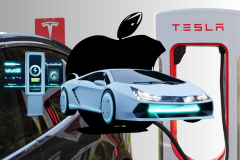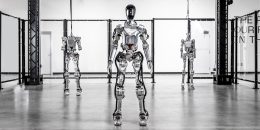On this Memorial Day weekend – traditional start of the racing season the US and the calendar home of the Indy 500 – we thought we’d take a look at the future of racing, and whether Ricky Bobby will find himself hammering it home in the driver’s seat…or pushing fries in the concession stand.
Autonomous racing isn’t just a distant dream anymore. Racing leagues – including aptly-named Roborace – are popping up promising spectators the opportunity to see driverless cars compete in virtual battles of algorithms. Teams of researchers are taking algorithms similar to those already being used by major brands like Tesla and Google to put cars on the open road and put them to work on the racetrack.
There is so much interest in the idea of pushing autonomous vehicle technologies to the extreme that track days have been set up to enable autonomous technologies developers to put their vehicles to he test on the track. Recently, Arrow Electronics broke records with its semi-autonomous vehicle at the Indianapolis Motor Speedway.
Could the day soon be at hand when we start seeing driverless cars tearing up tracks on mainstream television? Are NASCAR and Formula 1 drivers about to trade in their racing helmets for keyboards?
Autonomous vehicles take pole position
Driverless cars are already on our streets. In California, Google’s self-driving vehicles have clocked over 1.5 million miles with a far lower accident rate than humans by eliminating the 94% of traffic accidents that occur due to human error.
However, a new generation of autonomous vehicles are being developed in universities and corporate research and development departments around the world. Often described as the sexiest part of the Internet of Things right now — and for good reason, as brands like Google and Tesla are al over this space — technologies are being created that are enabling drivers to safely take their hands off the wheel and let the car do the driving.
So far, these technologies are only really good at this point for paved streets. But once you take your car off road, autonomous vehicles are at a disadvantage, what with different terrains, few markings, changing environments.
That’s where researchers at Georgia Tech are hoping to change things. They have created – and are racing – one-fifth-scale fully autonomous auto-rally cars that can navigate the slippery conditions of a windy dirt field racetrack at a break-neck equivalent to 90 mph.
The team has been developing complex algorithms that interpret data gathered from numerous sensors positioned around the vehicle to increase vehicular stability and maintain performance – even in the most difficult situations.
Dirt track racing is dangerous. The types of vehicles that compete in the sport are often banged up by the end of the race, and collisions are common. The track full-scale vehicles race on is slippery due to the loose earth, mud, and other debris that make up a dirt track.
Indeed, the day is quickly approaching when autonomous vehicles may far exceed even the best human drivers in driving capability. Or will they?
Humans not quite ready to turn over the keys yet
It could be argued that racing really isn’t racing unless a human is behind the controls. Do we consider computers computing data a sport? Are robots working the line at a car assembly plant taking part in a sport?
Even in robotic events like BattleBots, there is a human element behind the controller making real-time decisions about how and when to make the match-winning move. With true autonomous driving, the car is in control, and the x-factor dividing the winners and the losers are the algorithms created by the team before the race even begins.
Clearly, there are a few big differences between human and autonomous competitors in terms of entertainment value, as well.
To get a better understanding of the importance of the human element, we spoke with Blake Fuller, a professional driver and founder of GO PUCK.
“We (humans) look better on camera,” he laughed. “I know that AI would have no problem listing off their sponsors and what may have mathematically caused the accident, but would it have the passion of being pissed off when another driver caused the wreck or elated when they won?”
A big factor in the success of professional sports is the passion of the competitors involved. There is a story of struggle being told, and compelling tales of human achievement. Taking away the human element would be a novelty, but whether or not that novelty would last past the first season is yet to be seen.
There are also human elements to driving that even the most advanced AI are yet to surpass.
“Anticipation is 10 times faster than reaction,” Fuller said. “I believe that is true in business, racing and life. The human mind with skill and experience can perform quantum mechanic-like calculations to make decisions in racing currently at a rate which is just faster than computers.”
Anticipation and human instinct are often cited as the very elements that separate good drivers from great ones. At top speed, drivers can stay within inches of their competition and quickly adjust their speed and direction in an instant. AI may be able to sense a shift in a nearby car’s direction faster than a human, but its ability to predict that the change would take place without knowing the exact algorithm the other car is using is extremely limited.
But job security at 200mph?
But what about the day when fully autonomous cars can hit the track? Does Fuller see himself crunching number in the pits or in a luxury box in the stands?
“Sure, I would love to be there,” he says, adding that the duel life of racing and running a business are the bigger hurdles in his immediate future. He says he can’t even attend Indy as a fan this year, due to the needs of launching a new retail product and getting ready for Pikes Peak.”Candidly, while a computer can be in more than one place at once, it’s a trick I am still working on myself.”
But, he says, “what I would attend is a race where I was driving and competed head-to-head against autonomous cars.”
Whatever the advantages or disadvantages of autonomous racing, the one thing we know for certain is that it’s coming. Not only that, but that the type of work being put in to making high-speed and off-road racing safer will have a positive impact on safety – even on our much slower roadways.











